
Dunorlan Park
Encyclopedia
Dunorlan Park is a park and grounds in Royal Tunbridge Wells
, UK.
Totalling approximately 78 acres (31 hectares) and containing a 6 acres (24,281.2 m²) lake, the grounds were landscaped by Robert Marnock
for Henry Reed
, the merchant and philanthropist who owned the estate and the now-demolished house that once overlooked it.
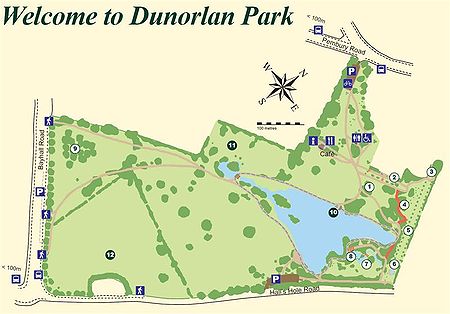
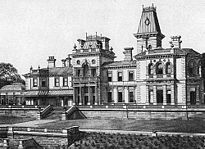 First record of the land is under the name of Burnthouse or Calverly Manor Farm which appears on a Tunbridge Wells map produced by John Bowra in 1738. After the death of the owner, a Mr Thomas Panuwell, in 1823, the farm was purchased by a land developer called John Ward, who intended to build a 1000 acres (4 km²) Calverly Estate to rival the lower village of Tunbridge Wells which was centred around the spring in the Pantiles.
First record of the land is under the name of Burnthouse or Calverly Manor Farm which appears on a Tunbridge Wells map produced by John Bowra in 1738. After the death of the owner, a Mr Thomas Panuwell, in 1823, the farm was purchased by a land developer called John Ward, who intended to build a 1000 acres (4 km²) Calverly Estate to rival the lower village of Tunbridge Wells which was centred around the spring in the Pantiles.
.jpg) However, in the 1850s the farmhouse and lands were purchased by Henry Reed who was the driving force behind the park as it stands today. Mr Reed demolished the house that stood on the grounds and built his own mansion, completed in 1862, which he named Dunorlan. In a sale brochure of 1871/2 the mansion was described as "a most elegant and substantial mansion, erected ... entirely of Normandy stone, in the Italian style of architecture, finished throughout in the most perfect manner, and in every way adapted for the comfort and enjoyment of a nobleman or gentleman of fortune". However, Mr Reed was "not at all satisfied with the house" on its completion and during its construction "he was not at all satisfied with the plan. The architect, however, said that his reputation was at stake and he would not have anything altered". As his family grew, he decided to pull down part of the building and erect a new wing. The 1881 Census (the house at this point now belonging to the Collins family) shows the house to have operated with 11 servants, a testament to its size.
However, in the 1850s the farmhouse and lands were purchased by Henry Reed who was the driving force behind the park as it stands today. Mr Reed demolished the house that stood on the grounds and built his own mansion, completed in 1862, which he named Dunorlan. In a sale brochure of 1871/2 the mansion was described as "a most elegant and substantial mansion, erected ... entirely of Normandy stone, in the Italian style of architecture, finished throughout in the most perfect manner, and in every way adapted for the comfort and enjoyment of a nobleman or gentleman of fortune". However, Mr Reed was "not at all satisfied with the house" on its completion and during its construction "he was not at all satisfied with the plan. The architect, however, said that his reputation was at stake and he would not have anything altered". As his family grew, he decided to pull down part of the building and erect a new wing. The 1881 Census (the house at this point now belonging to the Collins family) shows the house to have operated with 11 servants, a testament to its size.
To complement the house the surrounding fields were landscaped and formed into a park under the direction and design of Robert Marnock, one of the leading landscape designers of his day. These grounds were often used by Henry Reed in his evangelical pursuits, and during his last few years there he invited local Reverends to hold open air services under the fine beech trees on the lawn, with over 500 invitations to attend sent to the local gentry.
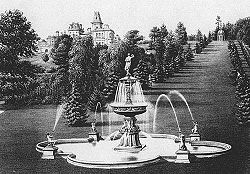
in 1870 and Dunorlan was put up for sale, with an original sales brochure remaining in the Tunbridge Wells museum today. The cause of this move is attributed by his widow (Mrs Margaret S.E Reed) to the fault some Christian people in England found with him because of the house. However, it proved difficult to find a buyer with two auctions being aborted in 1871 and 1872. Despite the favorable depictions of the property in the sales brochure (as quoted above), others viewed the mansion far less favourably, with a servant of the house describing it as "an architectural monstrosity (which) represented everything one might expect from a man with too much money and too little taste". Eventually it was sold to Brenton Halliburton Collins, a banker from Halifax
, Nova Scotia
and on his death, it was inherited by his son, Carteret Fitzgeral Collins who subsequently died in 1941. At this point the house fell vacant before being requisitioned for the war effort on 15 May 1941.
awarded two swans to the park. Boating on the lake began April 1949 and has continued to run every year since.
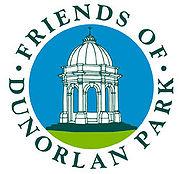
In February 2003, the Heritage Lottery Fund approved a grant of £2.1 Million towards the cost of the extensive restoration of the park, back to the original Robert Marnocks designs. The success of the application was likely aided by the English Heritage
listing Dunorlan on its National Register of Historic Parks and Gardens
, giving it Grade II listing in 2002.
as a spring which "rises rapidly into a stone basin, placed in the centre of a circular excavation, about ten feet in diameter and six or eight feet deep, which is bricked round, and with the remains of stone steps leading down to the basin at the bottom". (Number on map: 1)
(contributory to the River Medway
), which rises in the valley Dunorlan Park is set into. The river was dammed twice to form a pond, and subsequently the lake. The lake then flows over a cascade into the Victorian water garden and pond before reaching the fountain. Protracted repairs to the main dam required the lake to be lowered, drawing attention to the heavy silting and the failure of the stream feeding the water system.
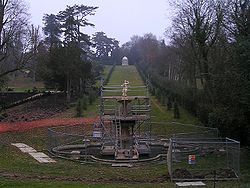 This is one of the stand-out features of the park and has been a major focus for the restoration efforts. The splendid fountain is adorned with dolphins, water nymphs and classical figures and is constructed out of Pulhamite
This is one of the stand-out features of the park and has been a major focus for the restoration efforts. The splendid fountain is adorned with dolphins, water nymphs and classical figures and is constructed out of Pulhamite
and terracotta.
The fountain was designed and built by the Pulham family, with high quality terracotta and Pulhamite (an artificial stone invented by the family) furniture a major aspect of their work. They became renowned for their work winning several medals and exhibiting at the Great Exhibition of 1862. One of the two works exhibited there was the upper section of what is now Dunorlan Fountain. Originally called the Hebe Fountain (due to the image of Hebe
- daughter of Zeus, at the top) James Pullham II received recommendation for the architectural decoration in terracotta. The fountain is shown clearly in the image from the Dunorlan Sales Brochure, with Hebe atop the central column and four kneeling Triton figures around the base. These details were long absent from the fountain, believed to have been used as target practice by the service men occupying the house during World War II, succumbing to the same fate as the statues that lined the avenue. However, the restoration project has completely renovated the fountain to return it to its former glory.
The fountain was a major focus of the restoration project and a new statue of Hebe was built in terracotta by specialist sculptors. While dismantling the fountain for repair other sections and figures were found in need of replacement. The four Triton figures on the outer edge of the fountain; spraying water back into the bottom pond, were not replaced for fear they would be easily damaged. The restoration won a Civic Trust Award for the restoration. (Number on map: 6)
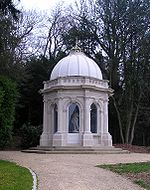 The Grecian Temple was built by the renowned Pulham family. Made from Portland stone
The Grecian Temple was built by the renowned Pulham family. Made from Portland stone
and some Pulhamite
, the temple stands at the top of the avenue leading down to the fountain at the base of the hill. The temple has been part of the focus of the restoration project, partly to reveal the detailed and colourful painting inside that had been covered by sections of modern paint. (Number on map: 3)
.jpg) The Dancing Girl is a statue that stood in the Grecian temple. It was gifted to the town by Alderman RD Burslem in 1951 for the enjoyment of the park and was sculpted by William Theed
The Dancing Girl is a statue that stood in the Grecian temple. It was gifted to the town by Alderman RD Burslem in 1951 for the enjoyment of the park and was sculpted by William Theed
a renowned Victorian sculptor. It has always been a favourite among visitors and is described as a "valuable part of the park's and the town's heritage", and "precious and historically significant". It depicts a scantily clad young girl draped in a cloth, holding a tambourine. It is reportedly worth £50,000.
, 8 May 1995.
In 2006, to mark the 400th anniversary of Royal Tunbridge Wells and the 150th anniversary of the Victoria Cross, Andrew Motion
(the poet laureate) was commissioned to write a poem, and Charles Gurrey to create a memorial sculpture. Extracts from Motion's poem Remembrance feature on the sculpture, which resides in the Grove. (Number on map: 9)
The ten Victoria Cross recipients remembered are:
Charles Davis Lucas
Mate (later rising to Rear Admiral) in the Royal Navy.
He was the first recipient of the Victoria Cross, receiving the medal from Queen Victoria on 26 June 1857 for action on board HMS Hecla
in 1854, during the Crimean War
.
Matthew Charles Dixon
Captain (later rising to Major General) in the Royal Regiment of artillery.
Captain Dixon gained his Victoria Cross soon after the outbreak of the Crimean War in 1855.
William Temple
Assistant Surgeon in the Royal Regiment of Artillery.
Honoured for his courage at the assault at Rangiriri, New Zealand in 1863.
John Duncan Grant
Lieutenant (later rising to Colonel) in the 8th Gurkha Rifles, Indian Army.
Awarded for action whilst storming Gyantse Jong fort, Tibet in 1904.
Douglas Walter Belcher
Lance Sergeant (later rising to Captain) in the 1/5th (City of London) Battalion, The London Regiment (The London Rifle Brigade).
Lance Sergeant Belcher was the first Territorial to receive the Victoria Cross, awarded for his bravery in Belgium in 1915, during World War I
.
William Robert Fountains Addison
Reverend, Chaplain of the Forces, 4th Class (later 2nd Class) in the Army Chaplains’ Department attached to the King’s own Royal Lancaster Regiment.
Awarded the Victoria Cross for his actions during World War I, at Sanna-i-Yat, Mesopotamia (present-day Iraq).
Eric Stuart Dougall
Acting Captain in the Special Reserve attached to A Battery, 88th Brigade of the Royal Field Artillery.
Eric Dougall gained his Victoria Cross for his action at Messines (near Ypres), Belgium in 1918, during World War I.
William Hew Clark-Kennedy
Lieutenant Colonel of the 24th Battalion, Quebec Regiment
(Victoria Rifles), Canadian Expeditionary Force.
For bravery displayed in France in 1918, during World War I.
Lionel Ernest Queripel
Captain in the Royal Sussex Regiment attached to the 10th Parachute Battalion.
Captain Queripel was awarded the Victoria Cross for his action in 1944, during fighting in Holland in World War II
John Henry Cound Brunt
Temporary Captain in the Sherwood Foresters (The Nottinghamshire
and Derbyshire Regiment), attached to the 6th Battalion The Lincolnshire Regiment.
John Brunt gained his Victoria Cross as a result of his leadership and bravery at Faenza, Italy in 1944, during World War II.
The large deodar cedars Marnock planted by the original drive to the house (now the Pembury Road entrance) still exist today and the restoration work has followed in the spirit of his style.
Green Flag Award
National Gold Green Apple Award
Royal Tunbridge Wells
Royal Tunbridge Wells is a town in west Kent, England, about south-east of central London by road, by rail. The town is close to the border of the county of East Sussex...
, UK.
Totalling approximately 78 acres (31 hectares) and containing a 6 acres (24,281.2 m²) lake, the grounds were landscaped by Robert Marnock
Robert Marnock
Robert Marnock was one of the outstanding horticulturalists and garden designers of the 19th century and was considered by his contemporaries to be the best exponent of the gardenesque school of landscape gardening....
for Henry Reed
Henry Reed (merchant)
Henry Reed was a British landowner, shipowner, merchant and philanthropist.In later life he moved to Royal Tunbridge Wells where he built an imposing mansion set into the beautiful grounds of Dunorlan Park designed by Robert Marnock....
, the merchant and philanthropist who owned the estate and the now-demolished house that once overlooked it.

Dunorlan is Built

.jpg)
To complement the house the surrounding fields were landscaped and formed into a park under the direction and design of Robert Marnock, one of the leading landscape designers of his day. These grounds were often used by Henry Reed in his evangelical pursuits, and during his last few years there he invited local Reverends to hold open air services under the fine beech trees on the lawn, with over 500 invitations to attend sent to the local gentry.

Robert Marnock's Influence
In designing the grounds of Dunorlan, Marnock adhered to his guiding principle of "harmony with nature". The lake was adapted to form a "fine ornamental sheet of water" and a "luxuriant avenue of deodoras and douglas picea, leading from a Grecian temple to a handsome stone basin and fountain".Henry Reed's Departure
Despite the huge expense and time invested in Dunorlan, Henry Reed moved to HarrogateHarrogate
Harrogate is a spa town in North Yorkshire, England. The town is a tourist destination and its visitor attractions include its spa waters, RHS Harlow Carr gardens, and Betty's Tea Rooms. From the town one can explore the nearby Yorkshire Dales national park. Harrogate originated in the 17th...
in 1870 and Dunorlan was put up for sale, with an original sales brochure remaining in the Tunbridge Wells museum today. The cause of this move is attributed by his widow (Mrs Margaret S.E Reed) to the fault some Christian people in England found with him because of the house. However, it proved difficult to find a buyer with two auctions being aborted in 1871 and 1872. Despite the favorable depictions of the property in the sales brochure (as quoted above), others viewed the mansion far less favourably, with a servant of the house describing it as "an architectural monstrosity (which) represented everything one might expect from a man with too much money and too little taste". Eventually it was sold to Brenton Halliburton Collins, a banker from Halifax
City of Halifax
Halifax is a city in Canada, which was the capital of the province of Nova Scotia and shire town of Halifax County. It was the largest city in Atlantic Canada until it was amalgamated into Halifax Regional Municipality in 1996...
, Nova Scotia
Nova Scotia
Nova Scotia is one of Canada's three Maritime provinces and is the most populous province in Atlantic Canada. The name of the province is Latin for "New Scotland," but "Nova Scotia" is the recognized, English-language name of the province. The provincial capital is Halifax. Nova Scotia is the...
and on his death, it was inherited by his son, Carteret Fitzgeral Collins who subsequently died in 1941. At this point the house fell vacant before being requisitioned for the war effort on 15 May 1941.
Dunorlan during World War II
Originally the mansion built by Reed was used to house troops, who are accused of using the statues lining the avenue from the Grecian temple to the fountain for target practice. In 1943 the War Damage Commission took up residence and stayed at the mansion for 14 years. Shortly after the family of Carteret Collins entered into negotiations with the Council regarding selling Dunorlan and the grounds to for the public benefit. Eventually the estate and other surrounding lands owned by the family were sold to the Council for £42,000.Dunorlan open to the public
Initially only intended to be temporary, 30 acres (121,405.8 m²) of land were opened to the public. This soon became permanent and Dunorlan Park was born, with the next two years seeing the installation of footpaths, fences and seats and in 1950 King George VIGeorge VI of the United Kingdom
George VI was King of the United Kingdom and the Dominions of the British Commonwealth from 11 December 1936 until his death...
awarded two swans to the park. Boating on the lake began April 1949 and has continued to run every year since.
Dunorlan House Fire
In 1946, the same year the park was opened to the public, a fire broke out in the house, while still being used by the War Damage Commission. Restorative works were performed to ensure the building was usable, but when the Commission surrendered the property back to the Council on 31 July 1957, the Council could find no use for it. In September 1957 it was sold for development and was demolished in the following year. Eight new houses were constructed on the site.Modern History
The tea pavilion that still operates today was built in 1966 and the park continued to operate unchanged until 1996 when meadows on the south side of the estate (previously leased out for grazing and thus not open to the public) were incorporated into the park, and are now managed for their wildlife interest. Other areas of these meadows are occasionally leased out for events and shows including the Horticultural Society Annual Show, and both the Chinese and Moscow State Circus.Restoration Project

The Friends of Dunorlan Park
The Friends of Dunorlan Park started as an informal conservation group in the 1990s, when signs of neglect and underinvestment were shown by many features in the park. After meetings with the Tunbridge Wells Council about restoration initiatives, an initial application for lottery funding, under the Urban Parks Programme was made. This application was turned down, but a subsequent application to the new Heritage Lottery Fund was submitted in 1999. In this time, The Friends of Dunorlan Park was officially launched in October 1996 and became a registered charity (No. 1063715/0) on 31 July 1997.In February 2003, the Heritage Lottery Fund approved a grant of £2.1 Million towards the cost of the extensive restoration of the park, back to the original Robert Marnocks designs. The success of the application was likely aided by the English Heritage
English Heritage
English Heritage . is an executive non-departmental public body of the British Government sponsored by the Department for Culture, Media and Sport...
listing Dunorlan on its National Register of Historic Parks and Gardens
National Register of Historic Parks and Gardens
In England, the Register of Historic Parks and Gardens of special historic interest in England provides a listing and classification system for historic parks and gardens similar to that used for listed buildings. The register is managed by English Heritage under the provisions of the National...
, giving it Grade II listing in 2002.
The Chalybeate Spring
After the discovery of the chalybeate spring in the area now known as The Pantiles in 1606, many local landowners attempted to establish rival springs on their own land. One such spring was situated at the then Burnthouse farm and can still be seen in Dunorlan Park today. It was described in 1832 (before Marnock came to design the landscape) by John BrittonJohn Britton (antiquary)
-Early life:Britton was born on 7 July 1771 at Kington St. Michael, near Chippenham. His parents were in humble circumstances, and he was left an orphan at an early age. At sixteen he went to London and was apprenticed to a wine merchant. Prevented by ill-health from serving his full term, he found...
as a spring which "rises rapidly into a stone basin, placed in the centre of a circular excavation, about ten feet in diameter and six or eight feet deep, which is bricked round, and with the remains of stone steps leading down to the basin at the bottom". (Number on map: 1)
The Terrace
The only surviving part of Dunorlan House is the terrace which lead to its entrance. Once gravelled, it is now paved with York stone and affords dramatic views across the park and of the surrounding farmland. (Number on map: 2)The Lake
The Lake totals approximately 6 acres (24,281.2 m²) and is supplied by the River TeiseRivers of Kent
There are four rivers draining the county of Kent, England.- River Medway :This is the main river, whose catchment area covers almost 25% of the county...
(contributory to the River Medway
River Medway
The River Medway, which is almost entirely in Kent, England, flows for from just inside the West Sussex border to the point where it enters the Thames Estuary....
), which rises in the valley Dunorlan Park is set into. The river was dammed twice to form a pond, and subsequently the lake. The lake then flows over a cascade into the Victorian water garden and pond before reaching the fountain. Protracted repairs to the main dam required the lake to be lowered, drawing attention to the heavy silting and the failure of the stream feeding the water system.
The Cascade
The cascade has changed little since it was built in the 19th century. It operates between the main lake and the water garden adjacent to the fountain. The deterioration of the Cascade was one of the main motivators behind seeking restoration of the park and the repairs were designed to ensure the operation of the cascade throughout the year. (Number on map: 8)The Water Fountain

Pulhamite
Pulhamite was a patented anthropic rock 'material' invented by James Pulham of the firm James Pulham and Son of Broxbourne.Pulhamite, which usually looked like gritty sandstone, was used to join natural rocks together or crafted to simulate natural stone features. The recipe went to the grave...
and terracotta.
The fountain was designed and built by the Pulham family, with high quality terracotta and Pulhamite (an artificial stone invented by the family) furniture a major aspect of their work. They became renowned for their work winning several medals and exhibiting at the Great Exhibition of 1862. One of the two works exhibited there was the upper section of what is now Dunorlan Fountain. Originally called the Hebe Fountain (due to the image of Hebe
Hebe (mythology)
In Greek mythology, Hēbē is the goddess of youth . She is the daughter of Zeus and Hera. Hebe was the cupbearer for the gods and goddesses of Mount Olympus, serving their nectar and ambrosia, until she was married to Heracles ; her successor was the young Trojan prince Ganymede...
- daughter of Zeus, at the top) James Pullham II received recommendation for the architectural decoration in terracotta. The fountain is shown clearly in the image from the Dunorlan Sales Brochure, with Hebe atop the central column and four kneeling Triton figures around the base. These details were long absent from the fountain, believed to have been used as target practice by the service men occupying the house during World War II, succumbing to the same fate as the statues that lined the avenue. However, the restoration project has completely renovated the fountain to return it to its former glory.
The fountain was a major focus of the restoration project and a new statue of Hebe was built in terracotta by specialist sculptors. While dismantling the fountain for repair other sections and figures were found in need of replacement. The four Triton figures on the outer edge of the fountain; spraying water back into the bottom pond, were not replaced for fear they would be easily damaged. The restoration won a Civic Trust Award for the restoration. (Number on map: 6)
The Grecian Temple

Portland stone
Portland stone is a limestone from the Tithonian stage of the Jurassic period quarried on the Isle of Portland, Dorset. The quarries consist of beds of white-grey limestone separated by chert beds. It has been used extensively as a building stone throughout the British Isles, notably in major...
and some Pulhamite
Pulhamite
Pulhamite was a patented anthropic rock 'material' invented by James Pulham of the firm James Pulham and Son of Broxbourne.Pulhamite, which usually looked like gritty sandstone, was used to join natural rocks together or crafted to simulate natural stone features. The recipe went to the grave...
, the temple stands at the top of the avenue leading down to the fountain at the base of the hill. The temple has been part of the focus of the restoration project, partly to reveal the detailed and colourful painting inside that had been covered by sections of modern paint. (Number on map: 3)
The Dancing Girl
.jpg)
William Theed
William Theed, also known as William Theed, the younger was an English sculptor, the son of the sculptor and painter William Theed the elder . Although versatile and eclectic in his works, he specialised in portraiture, and his services were extensively used by the Royal Family.-Career:Theed was...
a renowned Victorian sculptor. It has always been a favourite among visitors and is described as a "valuable part of the park's and the town's heritage", and "precious and historically significant". It depicts a scantily clad young girl draped in a cloth, holding a tambourine. It is reportedly worth £50,000.
- Theft of the Statue
- The Dancing Girl was stolen from Dunorlan Park on a Sunday night, 23 October 2006. The theft was discovered just before 8am Monday 24 October by a member of staff who noticed the glass window of Grecian temple had been removed. Vehicle tracks led from the top entrance of the park (that at Pembury Road) to the temple, but it is unknown how the statue was removed from the plinth it was attached to.
- A reward of £1500 is being offered by the Council for information leading to its return. Local Councilor James Scholes said; "We are anxious to see the statue safely returned". As of June 2007 the whereabouts of the statue is still unknown.
Victoria Cross Grove
The Victoria Cross Grove commemorates ten recipients of the Victorian Cross who had connections to the borough of Tunbridge Wells. The area was planted with 21 oak tress during the winter of 1994/5 and dedicated on the 50th anniversary of Victory in Europe DayVictory in Europe Day
Victory in Europe Day commemorates 8 May 1945 , the date when the World War II Allies formally accepted the unconditional surrender of the armed forces of Nazi Germany and the end of Adolf Hitler's Third Reich. The formal surrender of the occupying German forces in the Channel Islands was not...
, 8 May 1995.
In 2006, to mark the 400th anniversary of Royal Tunbridge Wells and the 150th anniversary of the Victoria Cross, Andrew Motion
Andrew Motion
Sir Andrew Motion, FRSL is an English poet, novelist and biographer, who presided as Poet Laureate of the United Kingdom from 1999 to 2009.- Life and career :...
(the poet laureate) was commissioned to write a poem, and Charles Gurrey to create a memorial sculpture. Extracts from Motion's poem Remembrance feature on the sculpture, which resides in the Grove. (Number on map: 9)
The ten Victoria Cross recipients remembered are:
Charles Davis Lucas
Charles Davis Lucas
Charles Davis Lucas VC was an Irish born officer of the Royal Navy and the first recipient of the Victoria Cross, the highest and most prestigious award for gallantry in the face of the enemy that can be awarded to British and Commonwealth forces...
Mate (later rising to Rear Admiral) in the Royal Navy.
He was the first recipient of the Victoria Cross, receiving the medal from Queen Victoria on 26 June 1857 for action on board HMS Hecla
HMS Hecla
Seven ships of the Royal Navy have been named HMS Hecla, after the volcano Hekla in Iceland.* The first Hecla was a 10-gun bomb vessel purchased in 1797...
in 1854, during the Crimean War
Crimean War
The Crimean War was a conflict fought between the Russian Empire and an alliance of the French Empire, the British Empire, the Ottoman Empire, and the Kingdom of Sardinia. The war was part of a long-running contest between the major European powers for influence over territories of the declining...
.
Matthew Charles Dixon
Matthew Charles Dixon
Major General Matthew Charles Dixon VC CB was a recipient of the Victoria Cross, the highest and most prestigious award for gallantry in the face of the enemy that can be awarded to British and Commonwealth forces....
Captain (later rising to Major General) in the Royal Regiment of artillery.
Captain Dixon gained his Victoria Cross soon after the outbreak of the Crimean War in 1855.
William Temple
William Temple (VC)
Lieutenant Colonel William Temple VC was an Irish recipient of the Victoria Cross, the highest and most prestigious award for gallantry in the face of the enemy that can be awarded to British and Commonwealth forces....
Assistant Surgeon in the Royal Regiment of Artillery.
Honoured for his courage at the assault at Rangiriri, New Zealand in 1863.
John Duncan Grant
John Duncan Grant
Colonel John Duncan Grant VC CB DSO was a recipient of the Victoria Cross, the highest and most prestigious award for gallantry in the face of the enemy that can be awarded to British and Commonwealth forces.-Details:...
Lieutenant (later rising to Colonel) in the 8th Gurkha Rifles, Indian Army.
Awarded for action whilst storming Gyantse Jong fort, Tibet in 1904.
Douglas Walter Belcher
Douglas Walter Belcher
Douglas Walter Belcher VC was an English recipient of the Victoria Cross, the highest and most prestigious award for gallantry in the face of the enemy that can be awarded to British and Commonwealth forces....
Lance Sergeant (later rising to Captain) in the 1/5th (City of London) Battalion, The London Regiment (The London Rifle Brigade).
Lance Sergeant Belcher was the first Territorial to receive the Victoria Cross, awarded for his bravery in Belgium in 1915, during World War I
World War I
World War I , which was predominantly called the World War or the Great War from its occurrence until 1939, and the First World War or World War I thereafter, was a major war centred in Europe that began on 28 July 1914 and lasted until 11 November 1918...
.
William Robert Fountains Addison
William Robert Fountains Addison
William Robert Fountains Addison VC was an English recipient of the Victoria Cross, the highest and most prestigious award for gallantry in the face of the enemy that can be awarded to British and Commonwealth forces....
Reverend, Chaplain of the Forces, 4th Class (later 2nd Class) in the Army Chaplains’ Department attached to the King’s own Royal Lancaster Regiment.
Awarded the Victoria Cross for his actions during World War I, at Sanna-i-Yat, Mesopotamia (present-day Iraq).
Eric Stuart Dougall
Eric Stuart Dougall
Major Eric Stuart Dougall VC MC was an English recipient of the Victoria Cross, the highest and most prestigious award for gallantry in the face of the enemy that can be awarded to British and Commonwealth forces....
Acting Captain in the Special Reserve attached to A Battery, 88th Brigade of the Royal Field Artillery.
Eric Dougall gained his Victoria Cross for his action at Messines (near Ypres), Belgium in 1918, during World War I.
William Hew Clark-Kennedy
William Hew Clark-Kennedy
William Hew Clark-Kennedy VC, CMG, DSO & Bar , was a Canadian recipient of the Victoria Cross, the highest and most prestigious award for gallantry in the face of the enemy that can be awarded to British and Commonwealth forces.He was 39 years old, and a lieutenant colonel in the 24th Battalion,...
Lieutenant Colonel of the 24th Battalion, Quebec Regiment
(Victoria Rifles), Canadian Expeditionary Force.
For bravery displayed in France in 1918, during World War I.
Lionel Ernest Queripel
Lionel Ernest Queripel
Lionel Ernest Queripel VC was an English recipient of the Victoria Cross, the highest and most prestigious award for gallantry in the face of the enemy that can be awarded to British and Commonwealth forces....
Captain in the Royal Sussex Regiment attached to the 10th Parachute Battalion.
Captain Queripel was awarded the Victoria Cross for his action in 1944, during fighting in Holland in World War II
World War II
World War II, or the Second World War , was a global conflict lasting from 1939 to 1945, involving most of the world's nations—including all of the great powers—eventually forming two opposing military alliances: the Allies and the Axis...
John Henry Cound Brunt
John Henry Cound Brunt
Captain John Henry Cound Brunt VC, MC was an English recipient of the Victoria Cross, the most prestigious award for gallantry in the face of the enemy that can be awarded to British and Commonwealth forces...
Temporary Captain in the Sherwood Foresters (The Nottinghamshire
and Derbyshire Regiment), attached to the 6th Battalion The Lincolnshire Regiment.
John Brunt gained his Victoria Cross as a result of his leadership and bravery at Faenza, Italy in 1944, during World War II.
Natural Play Area
Currently under construction is a new natural play area for pre-school and younger childrenFlora in Dunorlan
Dunorlan has a wide range of habitats ranging from meadows and grass land to hedgerows and shrubberies, walls and flower beds. When Marnock first developed the garden, many of the trees and shrubs were new introductions to the British gardening scene. Marnock's "Gardenesque" style emphasised the beauty of individual trees, making features out of distinctive trees and contrasting tones of various greens against light stonework.The large deodar cedars Marnock planted by the original drive to the house (now the Pembury Road entrance) still exist today and the restoration work has followed in the spirit of his style.
Tree Donation
As part of the restoration, the park runs a Tree Donation Scheme, in which, for between £450-550, a tree from a list can be selected and planted in a location agreed upon by the Head Gardener and those who donated.Awards
Green Heritage Site Status- is a new development under the Green Flag AwardGreen Flag AwardThe Green Flag Award is the benchmark national standard for parks and green spaces in the United Kingdom. The scheme was set up in 1996 to recognise and reward green spaces in England and Wales that met the laid down high standards...
scheme, sponsored by English Heritage. It marks the park as an area of national historic interest.
Green Flag Award
- which recognises the best green spaces in England and Wales.
National Gold Green Apple Award
- was awarded to the park in May 2006 for the built environmental and architectural heritage". The National Gold is the highest level that can be awarded by The Green Organisation which launched the award in 2000. Dunorlan was one of 50 winners out of 400 nominations.
Further reading
- The Tunbridge Wells Museum Project has information about access to the original Dunorlan sales brochure
External links
- Tunbridge Wells Borough Council has several pages about the park
- Friends of Dunorlan Park

